Valle de Mena
| Valle de Mena municipality | ||
|---|---|---|
 Landscape in the Valle de Mena
|
||
| coat of arms | Map of Spain | |

|
|
|
| Basic data | ||
| Autonomous Community : |
|
|
| Province : | Burgos | |
| Comarca : | Las Merindades | |
| Coordinates | 43 ° 6 ′ N , 3 ° 17 ′ W | |
| Height : | 319 msnm | |
| Area : | 263.17 km² | |
| Residents : | 3,726 (Jan 1, 2019) | |
| Population density : | 14.16 inhabitants / km² | |
| Postal code : | 09580 | |
| Municipality number ( INE ): | 09410 | |
| administration | ||
| Website : | Valle de Mena | |
Valle de Mena is a large municipality ( municipio ) with a total of 43 villages, hamlets and farmsteads with 3,726 inhabitants (as of January 1, 2019) in the province of Burgos in the northern Spanish autonomous region of Castile-León .
location
The Valle de Mena is located in the extreme northeast of the province of Burgos at an altitude of approx. 300 to over 1000 m above sea level. d. M. and forms the border area with the province of Bizkaia in the Autonomous Region of the Basque Country . The most important rivers are the Río Cadagua and the Río Ordunte , whose waters are the only ones in the Castile-León region to flow into the Bay of Biscay . The provincial capital Burgos is approx. 110 km (driving distance) in a south-westerly direction; the greater Bilbao area, on the other hand, is only about 45 km northeast. The climate in the region influenced by the mountains of the Cantabrian Mountains and the Biscay is temperate, but rainy (approx. 1000 mm / year); temperatures rarely drop below 0 ° C, even in winter.
Population development
| year | 1860 | 1900 | 1950 | 1991 | 2016 |
| Residents | 7,228 | 6.132 | 5,531 | 4,087 | 3,806 |
Since the middle of the 19th century, the population of the municipality has steadily declined, which is mainly due to the mechanization of agriculture and the associated loss of jobs.
economy
The region has been largely shaped by agriculture for centuries; the inhabitants of earlier times lived mainly as self-sufficient food from their fields and from cattle breeding (milk, cheese, meat), but handicrafts and small businesses also played a role in the larger towns. Since the middle of the 20th century, tourism (often in the form of renting out holiday homes) has been of increasing importance.
history
Numerous small stone and copper age finds have been made in the area of the municipality . In the time before the Roman conquest, the valley belonged to the settlement area of the Autrigones . In Roman times it was an important traffic and trade route between the northeast coast and the interior of the Iberian Peninsula . Visigoths and Moors left no traces. At the end of the 8th century the area was largely under Christian control; in the year 800 the (now disappeared) monastery of San Emeterio de Taranco was founded. In the 10th and 11th centuries, many families emigrated from the valley and settled the area around Meneses de Campos in the south of the Tierra de Campos in Castile . In the High Middle Ages, other small monasteries were built, and their churches are still standing today. The area was long disputed between the kingdoms of Castile and Navarre ; As a result, several castles and defense towers were built in the 14th and 15th centuries. In the 16th and 17th centuries, Spain's political and economic interest shifted to conquering and developing the New World ; the first judge of the Audiencia of Santo Domingo founded in 1511 , Sancho Ortiz de Matienzo , came from Villasana .
Attractions
- The single-nave monastery church of Santa María (Siones) ( 43 ° 4 ′ 2 ″ N , 3 ° 19 ′ 9 ″ W ) with its two archivolt portals in the style of late Romanesque dates from around the year 1200 . Its apse is structured on the outside by half-column templates , which in turn are connected by a surrounding cornice . The narrow window slots are framed by set columns and richly decorated arches. The interior of the apse and the short transept are divided by blind arcades and other arches; the interior design of both components is one of the highlights of Romanesque architecture in northern Spain.
- At the same time, the former monastery church of San Lorenzo (Vallejo de Mena) ( 43 ° 5 ′ 5 ″ N , 3 ° 18 ′ 5 ″ W ) was built, the three portals and apse of which are even richer than those of Santa María ( Siones) . The south side of the nave is emphasized by a defensive walkway , which is also meant to be representative, below the eaves . The archivolts of the west portal, which protrudes slightly from the wall, show two rows with hunting scenes, knights and musicians; other arches are decorated with vegetal ornaments. The nave and the apse dome are vaulted with unprofiled ribs . Some capitals show figurative motifs (e.g. St. Martin dividing the cloak or fighting knights on horseback).
- The figurative tympana of the parish churches of El Vigo and San Pelayo and the Romanesque sarcophagus in the church of Vivanco should also be mentioned .
- The Torre de Lezana is the keep ( Torre de homenaje ) the former castle ( castillo ) the family Velasco ; it dates from the 14th century.
Web links
- Valle de Mena, historical buildings - photos + information (Spanish)
- Valle de Mena, history - photos + information (Spanish)
- Santa María de Siones - Photos + Info (Spanish)
- San Lorenzo Vallejo - Photos + Info (Spanish)
Individual evidence
- ↑ Cifras oficiales de población resultantes de la revisión del Padrón municipal a 1 de enero . Population statistics from the Instituto Nacional de Estadística (population update).
- ↑ Valle de Mena - map with altitude information
- ↑ Villasana de Mena - climate tables



